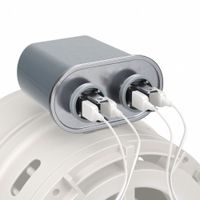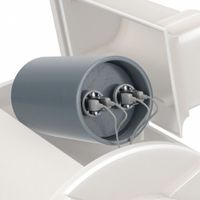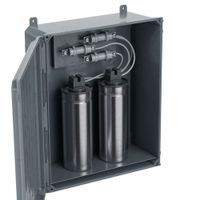Call +(254) 703 030 000 / 751 483 999 / 721 704 777
.....Read More
Frequently Asked Questions
What is the purpose of a motor capacitor?
A motor capacitor is an essential component in electric motors, primarily used to improve their performance and efficiency. It serves several key purposes:
1. **Starting Assistance**: In single-phase induction motors, a starting capacitor provides the necessary phase shift to create a rotating magnetic field. This helps the motor overcome inertia and start turning. Without this phase shift, the motor would not start on its own.
2. **Running Efficiency**: A run capacitor, often used in conjunction with a starting capacitor, helps maintain a consistent phase shift during operation. This ensures the motor runs smoothly and efficiently, reducing energy consumption and improving performance.
3. **Power Factor Correction**: Capacitors improve the power factor of the motor. A higher power factor means that the motor uses electrical power more effectively, reducing the amount of reactive power in the system. This can lead to lower electricity costs and reduced strain on the electrical grid.
4. **Voltage Stabilization**: Capacitors help stabilize voltage levels within the motor circuit. This is crucial for maintaining consistent motor speed and torque, especially under varying load conditions.
5. **Reduction of Electrical Noise**: By smoothing out voltage fluctuations, capacitors can reduce electrical noise and interference, which can be beneficial for sensitive electronic equipment connected to the same power source.
6. **Prolonging Motor Life**: By ensuring efficient operation and reducing electrical stress, capacitors can help extend the lifespan of the motor. They minimize overheating and wear on motor components, leading to fewer breakdowns and maintenance needs.
In summary, motor capacitors are vital for starting, running efficiency, power factor correction, voltage stabilization, noise reduction, and prolonging motor life, making them indispensable in various motor applications.
How do start capacitors differ from run capacitors?
Start capacitors and run capacitors are both used in electric motors to improve performance, but they serve different functions and have distinct characteristics.
Start capacitors are designed to provide an initial boost of energy to help start the motor. They are typically used in single-phase induction motors, where they create a phase shift in the motor's windings, generating a rotating magnetic field that initiates motor rotation. Start capacitors have a high capacitance value, usually ranging from 70 to 1200 microfarads (µF), and are designed for short-term use. They are only active during the motor's startup phase and are disconnected from the circuit once the motor reaches about 75% of its full speed, often by a centrifugal switch or a relay. Start capacitors are usually electrolytic, which allows them to store a large amount of charge temporarily.
Run capacitors, on the other hand, are used to improve the motor's running efficiency and performance. They remain in the circuit continuously while the motor is operating. Run capacitors have a lower capacitance value, typically between 1.5 to 100 microfarads (µF), and are designed for continuous duty. They help maintain a consistent phase shift, improving the motor's power factor and efficiency. Run capacitors are usually made of polypropylene film, which provides durability and stability for continuous operation.
In summary, start capacitors provide a temporary boost to start the motor, while run capacitors enhance efficiency and performance during operation. Start capacitors have higher capacitance and are used briefly, whereas run capacitors have lower capacitance and are used continuously.
What are the signs of a bad motor capacitor?
Signs of a bad motor capacitor include:
1. **Failure to Start**: The motor may not start at all, or it may struggle to start, indicating the capacitor is not providing the necessary initial boost.
2. **Humming Noise**: A humming or buzzing noise from the motor without it starting can suggest the capacitor is failing to deliver the required electrical charge.
3. **Intermittent Operation**: The motor may start and stop sporadically, as the capacitor fails to maintain a consistent charge.
4. **Overheating**: A bad capacitor can cause the motor to overheat due to inefficient operation, potentially leading to further damage.
5. **Reduced Performance**: The motor may run at a lower speed or with less power, as the capacitor is not effectively regulating the electrical flow.
6. **Physical Damage**: Visible signs of damage such as bulging, leaking, or corrosion on the capacitor itself can indicate failure.
7. **Burning Smell**: A burnt odor emanating from the motor or capacitor area can be a sign of electrical failure or overheating.
8. **Tripped Circuit Breaker**: Frequent tripping of the circuit breaker can occur if the capacitor is causing electrical issues within the motor.
9. **Increased Energy Consumption**: A malfunctioning capacitor can lead to higher energy usage as the motor works harder to compensate for the lack of proper electrical support.
10. **Vibrations**: Unusual vibrations or shaking of the motor during operation can be a symptom of capacitor issues.
11. **Capacitance Test Failure**: Using a multimeter to test the capacitance can reveal if the capacitor is outside its specified range, indicating a fault.
12. **Age and Wear**: Older capacitors are more prone to failure due to wear and tear over time, even if no immediate symptoms are present.
How do you test a motor capacitor?
To test a motor capacitor, follow these steps:
1. **Safety First**: Disconnect the power supply to the motor. Ensure the capacitor is fully discharged by shorting its terminals with an insulated screwdriver.
2. **Visual Inspection**: Check the capacitor for any visible signs of damage such as bulging, leaking, or burnt areas.
3. **Multimeter Test**:
- Set a digital multimeter to the capacitance setting (symbol: "C").
- Disconnect the capacitor from the motor circuit.
- Connect the multimeter probes to the capacitor terminals. Polarity does not matter for non-polarized capacitors.
- Read the capacitance value displayed on the multimeter. Compare it with the rated capacitance value printed on the capacitor. A significant deviation indicates a faulty capacitor.
4. **Resistance Test** (for analog multimeters):
- Set the multimeter to the highest resistance range.
- Connect the probes to the capacitor terminals.
- Observe the needle movement. It should initially deflect towards zero and then move back towards infinity, indicating the capacitor is charging. If the needle does not move or stays at zero, the capacitor is shorted. If it stays at infinity, the capacitor is open.
5. **ESR Meter Test** (for more accuracy):
- Use an ESR (Equivalent Series Resistance) meter to measure the internal resistance of the capacitor.
- Connect the ESR meter probes to the capacitor terminals.
- Compare the ESR reading with standard values for capacitors of similar ratings. High ESR indicates a failing capacitor.
6. **Replacement**: If the capacitor fails any of these tests, replace it with one of the same capacitance and voltage rating.
Always ensure safety by handling capacitors with care, as they can retain charge even when disconnected.
Can a motor run without a capacitor?
Yes, a motor can run without a capacitor, but it depends on the type of motor. Capacitors are primarily used in single-phase induction motors to create a phase shift for starting torque and improving efficiency. Here’s how it works for different types of motors:
1. **Single-Phase Induction Motors**: These motors typically require a capacitor for starting. The capacitor creates a phase difference between the current in the start winding and the run winding, generating a rotating magnetic field necessary for starting. Without a capacitor, these motors may struggle to start or may not start at all. However, once started, some motors can continue running without a capacitor, though performance and efficiency may be compromised.
2. **Capacitor Start Motors**: These motors use a start capacitor to provide the necessary starting torque. Once the motor reaches a certain speed, the start capacitor is disconnected by a centrifugal switch or relay. If the start capacitor is missing or fails, the motor may not start, but if manually started, it can run without the capacitor.
3. **Capacitor Start-Capacitor Run Motors**: These motors use both a start and a run capacitor. The run capacitor remains in the circuit to improve running efficiency and power factor. Without the run capacitor, the motor can still run, but with reduced efficiency and increased current draw.
4. **Three-Phase Motors**: These motors do not require capacitors for starting or running because they inherently produce a rotating magnetic field due to the phase difference in the three-phase power supply.
In summary, while some motors can run without a capacitor, it is generally not recommended due to potential issues with starting, efficiency, and performance.
How do you replace a motor capacitor?
1. **Safety First**: Turn off the power supply to the motor. Use a voltage tester to ensure no electricity is flowing.
2. **Access the Capacitor**: Locate the capacitor, usually found in the motor housing or attached to the motor. Remove any covers or panels to access it.
3. **Discharge the Capacitor**: Use an insulated screwdriver to short the terminals of the capacitor, discharging any stored electricity. Be cautious as this can produce a spark.
4. **Note the Connections**: Take a photo or make a note of how the wires are connected to the capacitor. This will help ensure correct reinstallation.
5. **Remove the Old Capacitor**: Use a screwdriver or pliers to disconnect the wires from the capacitor terminals. Remove any mounting brackets or screws holding the capacitor in place.
6. **Select the Replacement**: Ensure the new capacitor matches the old one in voltage and capacitance ratings. Check the physical size to ensure it fits in the same space.
7. **Install the New Capacitor**: Secure the new capacitor in place using the mounting brackets or screws. Reconnect the wires to the correct terminals as per your notes or photo.
8. **Double-Check Connections**: Ensure all connections are tight and secure. Verify that the wiring matches the original setup.
9. **Reassemble and Test**: Replace any covers or panels removed earlier. Restore power to the motor and test its operation to ensure the new capacitor is functioning correctly.
10. **Dispose of the Old Capacitor**: Follow local regulations for disposing of electronic components safely.
What happens if you use the wrong size capacitor?
Using the wrong size capacitor in a circuit can lead to several issues:
1. **Overvoltage/Undervoltage**: A capacitor with a voltage rating lower than required can lead to breakdown and failure, potentially causing short circuits. Conversely, a capacitor with a higher voltage rating than necessary may not fail, but it could be inefficient or unnecessarily large.
2. **Incorrect Capacitance**: Using a capacitor with incorrect capacitance can affect the circuit's performance. In timing circuits, it can alter the timing intervals. In filtering applications, it can change the cutoff frequency, leading to inadequate filtering.
3. **Resonance Issues**: In resonant circuits, the wrong capacitance can shift the resonant frequency, causing the circuit to operate inefficiently or not at all.
4. **Power Supply Instability**: In power supply circuits, an incorrect capacitor size can lead to voltage fluctuations, increased ripple, or instability, potentially damaging other components.
5. **Physical Size Constraints**: A physically larger capacitor may not fit in the designated space on a PCB, leading to mechanical issues or the need for redesign.
6. **Heat Dissipation**: A capacitor not rated for the circuit's current can overheat, leading to failure or reduced lifespan.
7. **Cost and Efficiency**: Using a capacitor larger than necessary can increase costs and reduce efficiency due to higher equivalent series resistance (ESR) and larger physical size.
8. **Safety Risks**: Incorrect capacitors can pose safety risks, including fire hazards if they fail catastrophically.
In summary, using the wrong size capacitor can lead to performance issues, inefficiencies, potential damage to the circuit, and safety hazards. It is crucial to select capacitors with the appropriate voltage rating, capacitance, and physical size for the specific application.
How long do motor capacitors typically last?
Motor capacitors typically last between 5 to 10 years. The lifespan of a motor capacitor can vary significantly based on several factors, including the quality of the capacitor, the operating environment, and the frequency of use. High-quality capacitors, designed for industrial applications, may last longer than those used in residential settings.
Environmental conditions play a crucial role in determining the lifespan of a capacitor. Capacitors exposed to high temperatures, humidity, or corrosive environments tend to have a shorter lifespan. Excessive heat is particularly detrimental, as it can cause the dielectric material within the capacitor to degrade more quickly.
The frequency and duration of use also impact longevity. Capacitors in motors that run continuously or are frequently started and stopped are subject to more stress, which can lead to a reduced lifespan. Additionally, voltage fluctuations and electrical surges can cause premature failure.
Regular maintenance and monitoring can help extend the life of a motor capacitor. Checking for signs of wear, such as bulging, leaking, or unusual noises, can prevent unexpected failures. Replacing capacitors before they fail can prevent damage to the motor and reduce downtime.
In summary, while motor capacitors generally last 5 to 10 years, their actual lifespan depends on quality, environmental conditions, and usage patterns. Regular maintenance and monitoring can help maximize their longevity.
What is power factor correction in motor capacitors?
Power factor correction in motor capacitors involves adjusting the power factor of an electrical system to improve efficiency and reduce energy losses. The power factor is the ratio of real power, which performs work, to apparent power, which is the combination of real power and reactive power. Reactive power does not perform work but is necessary for maintaining voltage levels in the system.
In AC motors, especially induction motors, the power factor is often less than one due to the presence of inductive loads that cause the current to lag behind the voltage. This lagging power factor results in increased current flow, leading to higher energy losses in the form of heat, increased demand charges from utilities, and reduced capacity of the electrical system.
To correct the power factor, capacitors are installed in parallel with the motor. These capacitors provide leading reactive power, which counteracts the lagging reactive power of the motor. By doing so, they bring the power factor closer to unity (1), meaning the current and voltage are more in phase.
Benefits of power factor correction include reduced energy losses, lower electricity bills due to decreased demand charges, improved voltage regulation, and increased capacity of the electrical system. It also reduces the load on transformers and generators, extending their lifespan.
Power factor correction can be achieved using fixed capacitors for constant loads or automatic capacitor banks for variable loads. The choice depends on the specific requirements of the electrical system and the nature of the load.
Overall, power factor correction in motor capacitors is a crucial practice for enhancing the efficiency and reliability of electrical systems, leading to cost savings and improved performance.
How do you discharge a motor capacitor safely?
1. **Power Off**: Ensure the power to the motor is completely turned off. Unplug the device or switch off the circuit breaker to eliminate any electrical supply.
2. **Verify Power Disconnection**: Use a multimeter to confirm that there is no voltage present in the circuit. Set the multimeter to the appropriate AC voltage range and check across the capacitor terminals.
3. **Identify the Capacitor**: Locate the capacitor in the motor circuit. It is usually a cylindrical or oval-shaped component with two or more terminals.
4. **Use a Resistor**: Obtain a resistor with a resistance value between 10,000 ohms (10k ohms) and 20,000 ohms (20k ohms) and a power rating of at least 2 watts. This will safely discharge the capacitor without causing a spark.
5. **Discharge the Capacitor**: Connect the resistor across the terminals of the capacitor. Hold the resistor with insulated pliers or use insulated alligator clips to attach it securely. Maintain the connection for several seconds to ensure the capacitor is fully discharged.
6. **Verify Discharge**: After discharging, use the multimeter set to the DC voltage range to check the voltage across the capacitor terminals. It should read close to zero volts, indicating the capacitor is discharged.
7. **Safety Precautions**: Always wear safety goggles and insulated gloves when working with capacitors. Ensure the work area is dry and free from conductive materials.
8. **Dispose or Reconnect**: If replacing the capacitor, ensure it is properly disposed of according to local regulations. If reconnecting, ensure all connections are secure and the capacitor is in good condition before restoring power.




